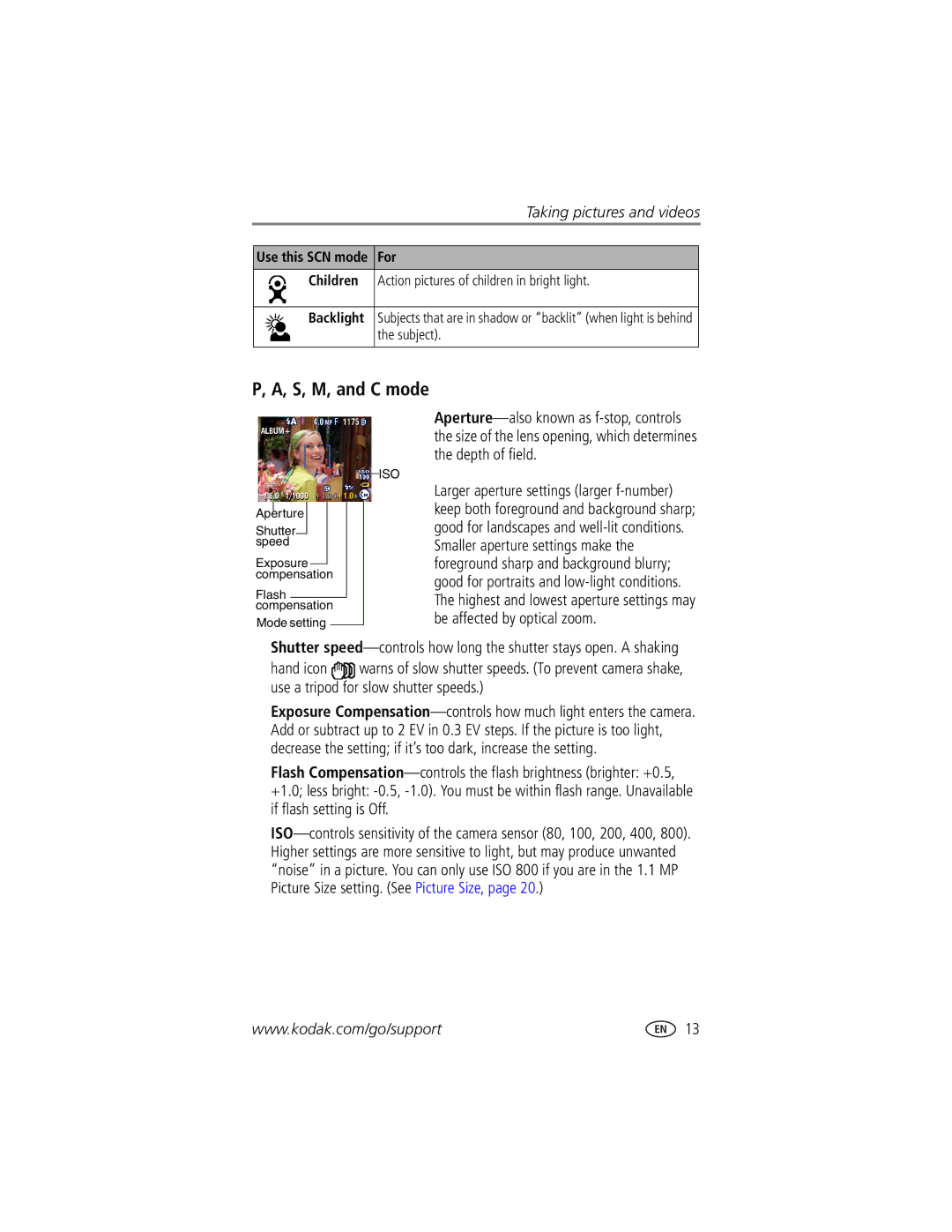User’s guide
Kodak EasyShare DX7440 zoom digital camera
Eastman Kodak Company State Street Rochester, New York
Top, Front View
USB Port Jog dial
Power ring
Side, Back View
Bottom View
Table of contents
Transferring pictures/videos with the USB cable
Installing the software first
Package contents
Getting started
Inserting the battery
Charging the battery
Close the battery door
Actual battery life may vary based on usage
Important battery information
Kodak battery replacement types/battery life
Extending battery life
Turning the camera on and off
Battery safety and handling
Changing the camera screen in Auto mode
To turn off the camera, turn the Mode dial to Off
Setting the date & time, anytime
Setting the date and time
Checking camera status in capture mode
Setting the date & time, first time
Storing pictures on an SD/MMC card
Using optional lenses
Push the card all the way into the slot Close the door
Taking a picture
Using the diopter dial
Taking a video
Using the auto-focus framing marks
While the shutter button is pressed halfway
Reviewing the picture or video just taken
Using optical zoom
Video. Press to adjust the volume
When taking videos, press and release the Shutter button
Scene
Using digital zoom
Use this mode For Auto
Camera modes
Manual
Use this mode For Aperture
Priority
Shutter
Scene modes
S, M, and C mode
Use the jog dial
Settings apply only in P, A, S, M, and C modes
Turn the Mode dial to P, A, S, M, or C
Press the jog dial to open the setting
Turning on the flash
Using the flash
Flash settings in each mode
Landscape pictures
Set the Mode dial to any Capture mode
Shooting close-up and landscape pictures
Close-up pictures
Using exposure compensation with exposure bracketing
Using exposure bracketing
Using burst
Changing picture-taking settings
Setting Icon Options Compression
Accessory Lens AF -usesTTL-AF
Center-weight
Focus Zone Multi-zone default
AF Control Continuous AF default no icon
Sepia picture to color
Using setup to customize your camera
Orientation Sensor On default
Setting Icon Options Print Warning
Sound Themes Shutter Only Default Classical Jazz Sci-Fi
Entering a mode Date & Time
First-on your computer
Pre-tagging for album names
Third-transfer to your computer
Second-on your camera
Highlight Exit, then press the OK button
Press the Review button
Checking camera status in review mode
Reviewing pictures and videos
Viewing single pictures and videos
Playing a video
Viewing multiple pictures and videos
Changing the camera screen
Deleting pictures and videos
Changing optional review settings
Magnifying pictures
Tagging pictures/videos for albums
Protecting pictures and videos from deletion
To interrupt the Slide Show, press the OK button
Running a slide show
Starting the slide show
Changing the slide show display interval
Running a continuous slide show loop
Copying pictures and videos
Review pictures and videos on the television
Press the Review button, then press the Menu button
Viewing picture/video information
Joystick . Press the Menu button to exit the menu
CD-ROM drive Available USB port
Installing the software
Minimum system requirements
Windows OS-based computers
Mac OS X-follow the on-screen instructions
Install the software
Print Favorite
When can I tag my pictures and videos?
Sharing pictures and videos
After pressing the Review button see
Printing tagged pictures
Tagging pictures for printing
Press the Share button. Press to locate a picture/video
Tagging pictures and videos for emailing
Second-tag pictures/videos on your camera
Third-transfer and email
Tagging pictures as favorites
Preventing favorites from transferring to the camera
Optional settings
Multi-up Setup Menu
Removing all favorites from your camera
Turn off the camera
Transferring and printing pictures
Transferring pictures/videos with the USB cable
Also available for transferring
Printing without a computer
Printing pictures from your computer
Ordering prints online
Printing from an optional SD/MMC card
Camera problems
Troubleshooting
Try one or more of the following
Computer/connectivity problems
Camera ready light status
Picture quality problems
Status Cause
Still having problems?
Software links
Getting help
Helpful links
Camera links
Telephone customer support
Amount of memory MB Exact error message you received
Before you call
Display
Camera specifications
Appendix
Kodak EasyShare DX7440 zoom digital camera
Flash
Kodak EasyShare DX7440 zoom digital camera Exposure
Capture
Tips, safety, maintenance
Picture storage capacity standard compression
Storage capacities
Number of pictures
Picture storage capacity fine compression
Power-saving features
Video storage capacity
FCC compliance and advisory
Upgrading your software and firmware Regulatory compliance
Vcci Class B ITE
Canadian DOC statement
English translation
To computer via USB cable, 42 custom
Backlight, 13 battery
Out, ii
Zoom
Locating holes for dock
Troubleshooting, 44 web links
About pictures, videos, 34 inserting
Storage capacity, 53
Self portrait, 12 shutter priority, 11 snow, 12 sports Text
Installing software on, 36 magnify picture, 30 manner
Package contents, camera, 1 party Pasm mode
Portrait, 12 power Auto off, save, 54 camera, 4 switch
Inserting, 6 printing from, 43 storage capacities, 53
Telephone numbers, 49 setting AF control Album
Protecting pictures, videos
Running slide show
Video date display, 26 videos

![]() warns of slow shutter speeds. (To prevent camera shake, use a tripod for slow shutter speeds.)
warns of slow shutter speeds. (To prevent camera shake, use a tripod for slow shutter speeds.)